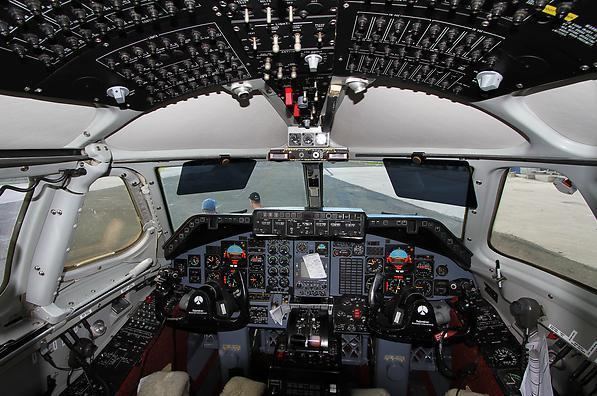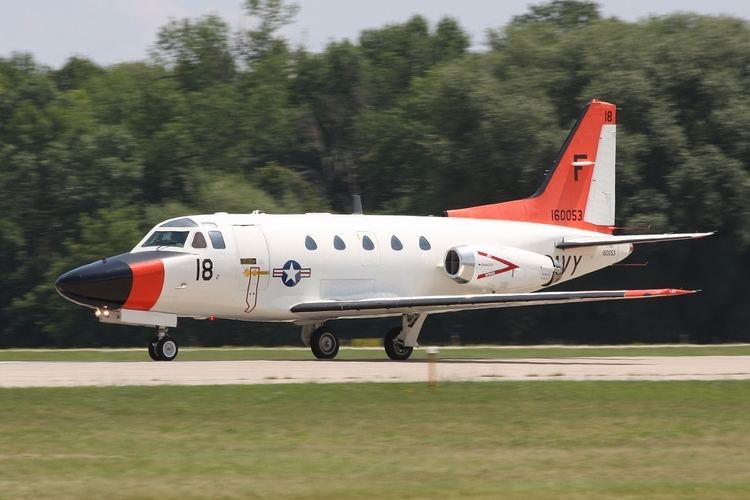Top speed 885 km/h Length 13 m First flight September 16, 1958 | Wingspan 14 m Introduced 1962 | |
 | ||
Manufacturers | ||
The North American Sabreliner, later sold as the Rockwell Sabreliner, is an American mid-sized business jet developed by North American Aviation. It was offered to the U.S. Air Force in response to their Utility Trainer Experimental (UTX) program. It was named "Sabreliner" due to the similarity of the wing and tail to North American's F-86 Sabre jet fighter. Military variants, designated T-39 Sabreliner, were used by the U.S Air Force, U.S. Navy and U.S. Marine Corps after the Air Force placed an initial order in 1959. The Sabreliner was also developed into a commercial variant.
Contents
- Design and development
- Civilian
- Military
- Operators
- Accidents and incidents
- Aircraft on display
- Specifications T3J 1T 39D
- References

Design and development

North American began development of the Sabreliner as an in-house project, and in response to the UTX request for proposals, they offered a military version to the Air Force. UTX combined two different roles, personnel transport and combat readiness training, into the same aircraft.

The civilian version prototype, which carried the model number NA-265, made its first flight on September 16, 1958. It was powered by a pair of General Electric YJ85 turbojet engines. The type received its FAA type certification in April 1963. The UTX candidate, designated the T-39A, was identical in configuration to the NA-265, but when the contract was awarded and the T-39A entered production, it was powered with two Pratt & Whitney JT12A-8 turbojet engines.
The civilian production version, or Series 40, was slightly refined over the prototype, with more speed and a roomier cabin. North American then stretched the design by 3 feet 2 inches, providing greater cabin space, and marketed it as the Series 60, which was certificated in April 1967. The cabin was made taller for the Series 70 and General Electric CF700 turbofans were installed for the Series 75A (also branded as the Series 80).
By 1973, North American had merged with Rockwell Standard under the name Rockwell International. In 1976 Rockwell contracted Raisbeck Engineering to redesign the wing of the Sabreliner series. The resulting Raisbeck Mark V wing was the first supercritical wing in service in the United States. The Mark V wing was combined with Garrett AiResearch TFE731 turbofan engines, to create the Series 65. Sabreliner models 60 and 80 were retrofitted with the Mark V wing as the Series 60A (STC SA687NW) and Series 80A (STC SA847NW).
Sabreliner production came to a close in 1981. The next year, Rockwell sold its Sabreliner division to a private equity firm which formed Sabreliner Corporation, the support organization for continuing operators.
Over 800 Sabreliners were produced, of which 200 were T-39s. A number of retired military T-39s have also entered the civilian world, since the military versions also carry FAA type certification. As of May 2007, 56 examples have been lost in accidents. The Series 65 was the last series run and 76 of them were produced, mostly for the private market. Monsanto has the oldest continuously operating company corporate jet division starting with its purchase of a Saberliner 40.
The original Navy version, the T3J-1, redesignated T-39D after the 1962 redesignation of USN/USMC/USCG aircraft, was initially fitted with the radar system from the F3H-1 Demon all-weather fighter and used as a radar trainer for pilots of that aircraft. The T-39D aircraft was subsequently introduced into the Basic Naval Aviation Observer (NAO), later Student Naval Flight Officer (SNFO) program. Three versions of the T-39D were used throughout the 1960s, 70s and 80s: one without radar for high altitude instrument navigation training and low altitude visual navigation training in the SNFO Intermediate syllabus, a second variant equipped with the APQ-126 radar from the Vought A-7 Corsair II for training primarily bombardier/navigators, reconnaissance attack navigators and electronic countermeasures officers in attack aircraft, and a third variant with the APQ-94 radar from the F-8 Crusader for training radar intercept officers in fighter aircraft.
The T-39N and T-39G are currently used in the NFO Strike and Strike Fighter syllabi in training USN and USMC Student Naval Flight Officers, various NATO/Allied/Coalition student navigators. Foreign students also train in the T-39 in place of the Beechcraft T-1 Jayhawk during the Intermediate Jet syllabus.
The Sabreliner requires a minimum crew of two, and depending on cabin configuration, can carry up to seven passengers (NA-265 through NA-265-40) or ten passengers (NA-265-60 and subsequent models). As a Navy flight training aircraft, it will typically fly with a pilot, one or two NFO Instructors and two to three Student NFOs or student navigators/CSOs.
Civilian
Military
Operators
Accidents and incidents
On January 28, 1964, a USAF T-39 Sabreliner flying from West Germany on a training mission crossed into East German airspace and was shot down by a Soviet MiG-19 near Vogelsberg, killing all three aboard.
On April 13, 1973, a Sabreliner NA-265-60 operated by Continental Airlines, N743R, crashed after takeoff at Montrose Airport in Montrose, Colorado following the uncommanded deployment of the port side thrust reverser. The two pilots, the only occupants of the aircraft, were killed and the aircraft was destroyed by impact forces and a post impact fire.
On February 23, 1975, a Sabreliner 75A operated by General Motors with registration number N5107, crashed on final approach 4 miles from Pontiac, Michigan. The aircraft was damaged beyond repair. The only occupants of the aircraft were the pilot and co-pilot, of which the pilot was killed in the crash. The accident was attributed to improper IFR operation.
On December 21, 1975, BuNo 157352, a USN T-39E conducting a Transport Aircraft Commander-Syllabus One (TAC-1) flight, crashed along the Mendocino Ridge, approximately ten miles southwest of Ukiah, California. Two U.S. Navy pilots were aboard and both were killed.
On April 1, 1977, BuNo 150545, a USN T-39D was conducting a Student Naval Flight Officer low-level flight training sortie, crashed in the Laguna Mountains eight miles east-southeast of Julian, California killing all five instructors and students aboard.
On April 20, 1985, AF ser. No. 62-4496, a USAF CT-39A experienced brake failure on landing at the Wilkes-Barre Scranton International Airport, killing all five passengers and crew aboard, including General Jerome F. O'Malley, Commander, Tactical Air Command.
On June 3, 1988, an Ecuadorian Air Force Rockwell Sabreliner 60 clipped a building and crashed in a residential area of Quito, killing all ten people on board (including the commander of the Ecuadorian Army), and another three people on the ground.
On July 12, 1988, a US Navy CT-39E ditched off the coast of Vietnam after running low on fuel following failure of the aircraft's navigation issues. The crew of three was rescued by the Vietnamese Navy and returned to the United States.
On May 8, 2002, two USN T-39Ns from Training Squadron 86 (VT-86) at NAS Pensacola, Florida, collided in mid-air during Student Naval Flight Officer air intercept training in a military Warning Area 40 miles off the Gulf Coast, killing all seven instructors and students on board the two aircraft.
On January 13, 2006, a USN T-39N Sabreliner conducting Student Naval Flight Officer/Student USAF Navigator-Weapon Systems Officer low-level flight training crashed in a densely forested area in rural Georgia, killing all four crew members.
On August 16, 2015, a private Sabreliner collided with a Cessna 172 on approach to Brown Field Municipal Airport in southern San Diego County, California, killing the five people aboard the two aircraft. The cause was found to be Air Traffic Control error.
Aircraft on display
Specifications (T3J-1/T-39D)
Data from T-39 Sabreliner on Boeing History site
General characteristics
Performance
